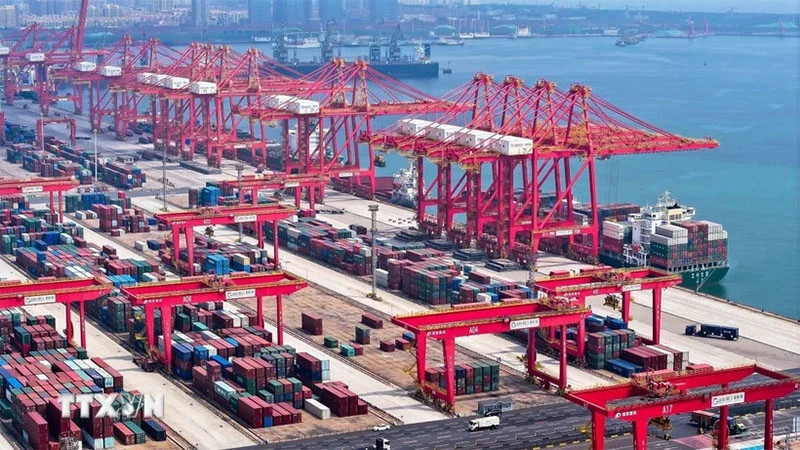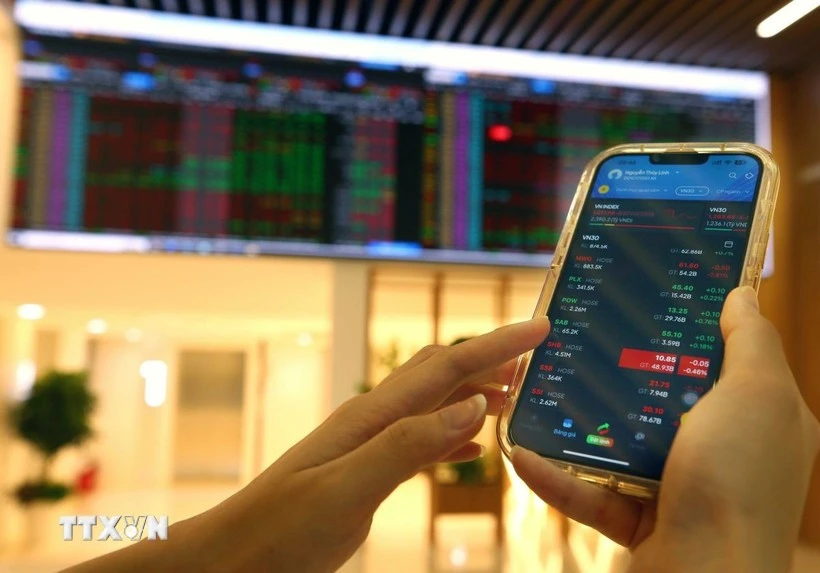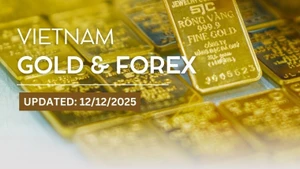On April 10, President Donald Trump announced the suspension of reciprocal tariffs on more than 75 countries.
The US move is also considered not only an economic measure but also a diplomatic strategy to reduce trade pressure and facilitate negotiations with strategic partners.
Accordingly, the parties have more time to adjust their strategies, while market stabilisation measures - from monetary policy to foreign exchange management - also become more feasible.
Gold continues to increase in price
Gold has always been considered a “safe haven” by investors in the context of global economic and political instability. In recent days, gold prices have increased continuously. On April 15, the world gold price was trading around 3,220 USD/ounce. In Vietnam, the price of SJC gold bars set a new record of 108 million VND/tael, with gold rings trading around 105 million VND/tael, depending on the brand.
According to Nguyen Quang Huy, CEO of the Faculty of Finance and Banking at Nguyen Trai University, gold is an important psychological indicator for investors in the face of major fluctuations in trade, interest rates and global macroeconomic policies.
The sharp increase in tariffs on China and the extension of tariffs on some friendly countries of the US are causing the global financial market to fluctuate in a “defensive” direction.
In the context of increasing trade risks and geopolitical instability, gold continues to play its role as a safe-haven asset. Globally, gold prices are on an upward trend due to concerns about prolonged trade conflicts, affecting global growth, and investment capital flowing into safe assets.
The USD is strengthening in the short term because money flows to the US, but the instability from trade policy makes investors uncertain about stocks, pushing up gold demand.
“In Vietnam, domestic gold prices continue to be high, the gap with world prices may widen if the world situation worsens or there is a wave of hoarding by domestic investors. If FDI capital flows increase sharply, the abundant USD supply can help stabilise the exchange rate, indirectly restraining gold prices. But if global inflation escalates or the USD is too strong, gold prices may increase further,” said Nguyen Quang Huy.
Economic experts also assessed that, in the context of the gold market always being affected by both global and domestic factors, the demand for hoarding by people and businesses is also affected by the management policy of the State Bank of Vietnam.
If the negotiation with the US is successful, the flow of foreign currency from exports will be maintained, reducing pressure on the exchange rate, thereby helping the State Bank have more room to control the domestic gold market.
Skillfully "balancing" exchange rates and interest rates
The VND/USD exchange rate can be a sensitive index, directly reflecting the impact of international trade policies. Before the US announced the postponement of the tax, the market recorded a sudden increase of about 0.6% on the first day after President Trump's tax announcement due to concerns about the negative impact of tax increases on Vietnam's export turnover.
According to initial forecasts by experts, if the tax is applied as planned (46%), the exchange rate could increase by 3-5% in a short time.
However, the decision to postpone the tax has created a "cool breeze" for the foreign exchange market. Specifically, in the morning trading session on April 10, the exchange rate at commercial banks recorded a sharp decrease of up to 182 VND, helping the transaction close at 26,000 VND/USD. On April 15, the central exchange rate was listed by the State Bank at 24,891 VND/USD. The USD buying and selling prices at all commercial banks were traded around 25,580-26,106 VND/USD (buy-sell).
After the decision to postpone the tax, the international financial market responded positively, which reduced investors' concerns about the global trade situation. When trade tensions temporarily subsided, the demand for USD reserves in Vietnam decreased, causing the exchange rate to decrease slightly.
On the other hand, domestic economic data also showed that the Vietnamese economy is maintaining a stable growth momentum, which contributed to reducing pressure on the exchange rate.
However, despite the tax postponement, the 10% rate will still be applied, so the export group will still be more or less negatively affected compared to before.
However, domestic consumption demand in the US is still being observed, so the trend of shifting supply chains to politically stable countries remains the main trend.
Governor of the State Bank of Vietnam Nguyen Thi Hong also affirmed that this agency will continue to closely monitor domestic and international market developments, thereby taking accurate management measures to ensure exchange rate stability in the context of an ever-changing world.
Thus, the decision to temporarily postpone taxes has not only opened up opportunities for exchange rate stability but also created conditions for the State Bank of Vietnam to be more flexible in managing interest rates.
Experts believe that in the coming days, when the pressure from tax policy is reduced, the State Bank will have "room" to consider a policy of reducing interest rates to support key economic sectors such as seafood, textiles and footwear - sectors directly affected by this tariff measure.
The Vietnam Economic Growth Report in the first quarter of 2025, issued by the Global Economics and Market Research Department of United Overseas Bank (UOB), recently stated that the State Bank of Vietnam has more room to loosen monetary policy, but unfavourable external factors may affect the VND/USD exchange rate.
UOB's current baseline scenario is that the State Bank will keep the policy interest rate unchanged, with the refinancing rate maintained at 4.5%. However, the risk trend is leaning towards the possibility of a rate cut due to the downward pressure from business and export activities, in the context of external difficulties affecting the Vietnamese economy.
“If the domestic business and labour market conditions deteriorate significantly in the next 1-2 quarters, we see the possibility of the State Bank cutting the policy rate to the COVID-19 low of 4%, followed by a further 50 basis points reduction to 3.5%,” the UOB’s experts forecast.
This forecast is based on the assumption that the foreign exchange market is stable and the US Federal Reserve (FED) implements interest rate cuts as expected.
















